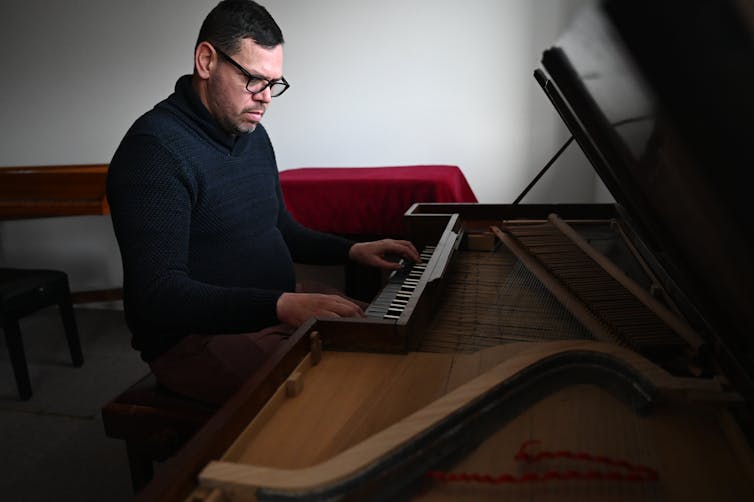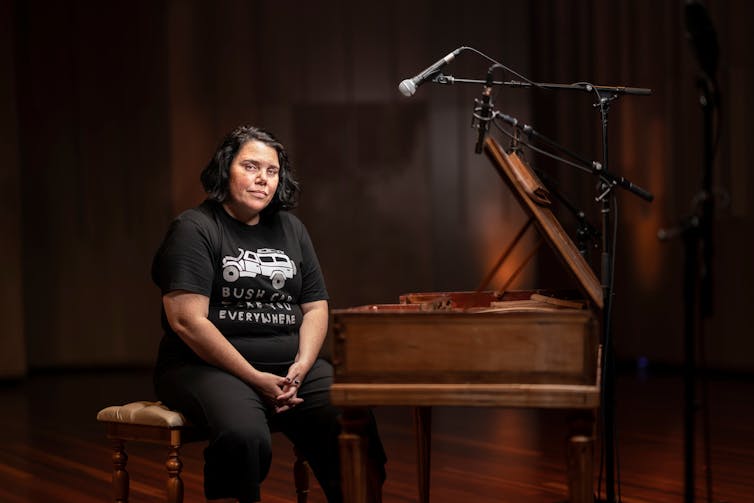Source: The Conversation (Au and NZ) – By Christopher Sainsbury, Senior Lecturer Composition, Australian National University
Despite having different cultural backgrounds and experiences — Indigenous composers with an Indigenous mentor, and a pianist descended from Anglo-colonial history — it is nevertheless possible to create a project that can serve as a focus for unification and strength.
In our instance, the trigger was a relic of the past. Specifically, an historical object made at a time of great significance for Australia: a square piano built around 1770, housed in the keyboard archives of the School of Music at ANU.
Its place of manufacture was Alsace in western Europe, a small body of land that has at times been claimed by Germany, at other times by France. The disputed nature of the territory serves as an ironic parallel to our project.
Given the historical importance of the time of manufacture — when James Cook was charting the eastern coast of Australia — we asked four Indigenous composers, all of whom have been through the Moogahlin Performing Arts and Ngarra-burria First Nations composers program, to write new music for the piano. The brief was simple: write something for the instrument, with the option of one other instrument or voice, to a length of around five minutes.
All four composers interpreted the project in thoroughly different ways, reflecting their unique artistic approaches and perhaps highlighting issues relating to previous attempts at addressing and improving the situation created by the past. Today, recordings of their works on Ngarra-burria Piyanna are being released for streaming and download.The instrument
The piano was built by Henri Henrion in a small village near to Sareguemines. Little is known about the builder, except that he eventually became involved in politics and got swept up in the events of the French Revolution.
Similar to other square pianos, including the instrument that came out on the First Fleet, it creates a sound that is far lighter than that of a modern piano.

From the outset, it was clear there could be challenges. It is undeniably confronting to ask people whose culture was so thoroughly subjugated to “get creative” with an object that could be seen as crucially symbolic of white history. It was joked that the creativity might take the form of matches and a chorus for a bonfire!
The compositions were recorded in Canberra last year, and were featured in a podcast broadcast on ABC radio, whose generous funding under the auspices of a Fresh Start Fund grant made it all possible.
Read more: It’s time to properly acknowledge – and celebrate – Indigenous composers
From rap to gothic vampires and protest songs
Rhyan Clapham, who works as a rapper with the pseudonym DOBBY, is the only composer who also performs their track, both on the square piano and vocals.
He set his goal as delivering a 250-year history of Australia, from the time the piano was made to the present. He enjoyed the process.
The team produced this unique project effectively and respectfully. There was a certain feeling shared by all of us that something quite special was happening.
The work by music student Elizabeth Sheppard, called Kalgoorli Silky Pear, draws on the history of her ancestors who resided in Western Australia generations before. It also incorporates an element of her Scottish lineage, through a hint of a lullaby towards the end. As a composer familiar with older musical styles, she has incorporated elements of Indigenous polyphony in a thoughtful way.
In Lupe’s Waltz, Tim Gray has imagined the pianist as a vampire. He has written a vocal line for a witch, all dreamed up in a gothic throwback to a Romanian grand ball. While we often look to Indigenous composers for cultural insights, there are less apparent metaphors in Tim’s music that may pass us by. This subtlety is part of the magic of the piece.
In writing about her work, The Binary, songwriter and storyteller Nardi Simpson (also a student at the School of Music) has been powerfully honest in recounting her initial reaction to the commission.

Read more: Together we rise: East Arnhem Land artists respond to COVID-19 with the gift of music
This piano — such a reminder of the horrors of colonisation for Indigenous peoples — was perhaps a foe and not a friend. So, ingeniously, Nardi took eight popular protest chants and coded them into complex rhythmic patterns. These then mingle and overlay. They create a transcendent and deeply meaningful musical landscape.
Rather than mask the sounds of the mechanical inner working of the instrument, the pieces were recorded with complete authenticity. In a sense, this decision stands as a symbol for the project: with honesty, authenticity, and a shared passion, music can show a way forward to a brighter future.
Read more: Terra nullius interruptus: Captain James Cook and absent presence in First Nations art
– ref. Four Indigenous composers and a piano from colonial times — making passionate, layered, honest music together – https://theconversation.com/four-indigenous-composers-and-a-piano-from-colonial-times-making-passionate-layered-honest-music-together-152080







